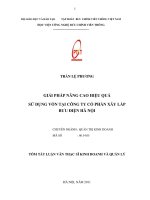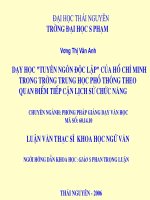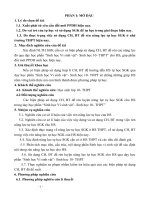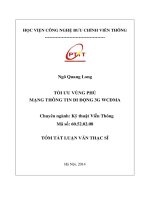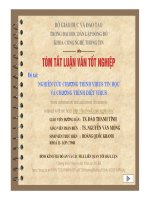tóm tắt luận văn: abstract of graduation thesis an investigation of common errors
Bạn đang xem bản rút gọn của tài liệu. Xem và tải ngay bản đầy đủ của tài liệu tại đây (642.08 KB, 16 trang )
ACKNOWLEDGEMENTS
During the process of doing this graduation paper, I have received many
necessary assistances, precious ideas and timely encouragements from my
teachers, family and friends. This paper could not have been completed without the
help, encouragement and support from a number of people who all deserve my
sincere gratitude and appreciation.
First of all, I wish to express my deepest gratitude to my supervisor - Ms.
Truong Hoang Lan, M. A, who has always been willing to give me valuable advice
and suggestions in order that I can complete successfully this study.
I also would like to take this opportunity to show my sincere thanks to all my
lecturers at the Faculty of Foreign Languages of Pham Van Dong University, who
have handed me basic knowledge to complete this study.
I am so thankful to students of two classes 11A2 and 11A3 at Mo Duc No II
High School for their whole - heart participation in the study.
I am equally indebted to my classmates for their suggestions and
encouragements in the progress of my study.
Last but not least, my particular thanks are given to my parents for their
encouragement and support which played an important role in my graduation
paper.
1
TABLE CONTENTS
ACKNOWLEDGEMENTS………………………………..…………………….…1
TABLE OF CONTENT……………………………………………..………..……2
CHAPTER I: INTRODUCTION………………………………………………. .4
1.1. Rationale of the study…...…………………………………………………... 4
1.2. Aim of study…………………………………………………………………..5
1.3. Scope of the study………………………………………………………….…5
1.4. Research questions………………………………………………………...…5
1.5. Methodology…………………………………………………………………..5
1.6. Organization of the study……………………………………………………5
CHAPTER II: LITERATURE REVIEW……………………………………….7
2.1. Review of Previous Studies………………………………………………......7
2.1.1. Writing in the English class: The key to Improve the Vietnamese eleventh
grader as a Foreign Language Learner’s Productive Writing Skill……………..….7
2.2. Theoretical Background…………………………………………………....7
2.2.1. Theories of Writing Skill…………………………………………………7
2.2.1.1. Writing Skill Definition…………………………………....................7
2.2.1.2. Writing Skill in Teaching Foreign Language…………………………7
2.2.1.2.1. The Importance of Writing Skill in Teaching Foreign
Language………………………………………………………………………..…7
2.2.1.2.2. The difficulties of Writing Skill in Teaching Foreign
language…………………………………………………………………………...7
2.3. Overview on Cause and Effect Essay……………………………………..8
2.3.1. What is an essay? ..................................................................................8
2.3.2 Types of essays Used in Academic Writing……………………………….8
2.3.3. The Definition of Cause and Effect Essay……………………………….8
2
2.3.3.1. Structure of Cause and Effect Essay……………………………..…..8
2.3.4. Process of a Cause and Effect Essay……………………………………..9
2.4. Rules for a Good Cause and Effect Essay…………………………………..9
CHAPTER III: METHODS AND PROCERDURES…………………….…...11
3.1. Research Methodology………………………………………………….…..11
3.2. Research Procedures…………………………………………………….….11
3.3. Data Collections……………………………………………………………..11
3.4. Data Analysis………………………………………………………………...11
3.5. Reliability and Validity………………………………………………….….11
CHAPTER IV: FINDINGS AND DISCUSSIONS………………………...…..12
4.1. Some Errors in Writing Cause and Effect Essay………………………….12
4.1.1. Repeating Transitional Words in an Essay…………………………….....12
4.1.2. Omitting Transition Words in an Essay……………………………….....12
4.1.3. Incorrect Topic Sentences in Body Paragraph…………………...............12
4.2. Some Suggestions to Improve Writing Cause and Effect Essay…............12
4.2.1. Using Various Transitional Words…………………………………….…12
4.2.2. Writing Correct Topic Sentences………………………………………...13
CHAPTER V: CONCLUSION AND IMPLICATION……………………...14
5.1. Conclusion……………………………………………………………….…14
5.2. Implications…………………………………………………………………14
REFERRENCES……………………………………………………………….15
3
CHAPTER I: INTRODUCTION
1.1. Rationale of the study
Nowadays, almost countries in the world speak English and English can be
considered one of the most essential languages for international communication. In
Vietnam, there are a lot of foreign investors, they establish their own companies in
Vietnam. They all speak English and of course, they will employ the people who
have ability of using English. Therefore, English is an important criterion to find a
good job in Vietnam. It becomes the second language to many people. When we
learn English, we can widen knowledge about culture, customs, lifestyle in each
countries. However, it is not easy to learn a foreign language well. In order to use
English fluently, I think the learners have to pay attention to four skills: Reading,
Writing, Listening and Speaking. Of four skills, writing is considered the most
difficult skill in all. Different from the rest, writing requires not only the learners to
have knowledge of grammar (grammatical structures) but also plentiful source of
vocabulary to write a paragraph as well as an essay completely. Many learners
think that when they can speak well, they will automatically write well. However,
when they begin writing first sentence, everything is not easy as they expected.
There are many differences between spoken and written languages. So, writing
requires much patience and constant practice.
In all walks of life, people use writing as a basic working skill. It is a
process, a skill of hard- work and people must perform almost daily. As a student,
you will have a lot of writing tasks such as: assignments, essay, graduation training
report, graduation paper,… Therefore, we should think clearly about what to write,
how to write in order to have a good writing. To my knowledge, there are many
factors which help learners write an essay successfully. During studying writing
skill, especially writing essay, I am very interested in Cause and Effect essay, I
realized how important they are and their effects when being used to write a
paragraph or an essay. But due to the limitation of time, the study on how to write
a Cause and Effect essay effectively is not introduced clearly in writing subject.
Students do not have chance to understand much about them. With the hope that I
can study more about Cause and Effect essay deeply. Thus, I decided to choose a
study on how to write a Cause and Effect essay, some common errors made by
high school students in writing Cause and Effect English essay and suggestions for
solutions as my graduation paper.
4
1.2. Aims of the study
The study “Some common errors made by high school students in writing
Cause and Effect English essay and suggestions for solutions” is carried out in
order to survey the skills of writing of high school students, especially the students
at Mo Duc No II High School. The study provides learners with the theoretical
background of writing, such as the theory of academic writing, essay and
especially, the theory of Cause and Effect essay. It also points out the common
mistakes facing the learners in the process of writing Cause and Effect essay and
gives some advices, specific exercises to help English learners improve writing
Cause and Effect effectively.
1.3 Scope of the study
Cause and Effect essay is used in every types of discourse, such as speaking,
reading, listening and especially in writing. However, due to the limitation of time,
of knowledge and materials, I can only focus on theory of Cause and Effect essay,
types of errors which students often make and methods to help students write the
essay effectively.
1.4. Research questions:
1. How do students understand about Cause and Effect English essay?
2. What are the common errors which students often make?
3. What are the solutions to help students write Cause and Effect English
essay effectively?
1.5. Methodology
To fulfill the above aims, qualitative and quantitative methods were chosen
for the study. All comments, remarks, assumptions and conclusion of the study
were based on the data and analysis. Data collections for analysis in this study
were gained through the following the survey questionnaires resources.
1.6. Organization of the Study
This paper presented in five chapters. They are:
Chapter I( Introduction)
The author provides information about the rationale of the study, states the
aims of the study, specifies the scope of the study, research questions, research
methodology as well as organization of the study.
5
Chapter II (Literature Review)
Provides the previous study, the theoretical foundation of teaching writing.
Chapter III (Methods and Procedures)
Mentions methods and procedures including the research methods and
procedures, data collection, data analysis, reliability and validity.
Chapter IV (Findings and Discussions)
Elaborates the procedures of the study in order to give clear answers to the
study questions that have been proposed before. The findings and discussions
presented based on the data that analyzed and they are related to the theoretical
background in chapter two.
Chapter V (Conclusion and Implications)
Presents the conclusion of this study, the implications for teaching and
learning, the limitations of the study and some suggestions for further study.
6
CHAPTER II: LITERATURE REVIEW
2.1. Review of Previous Studies
2.1.1. Writing in the English class:
“The Key to improve the Vietnamese eleventh grader as a Foreign
Language Learners’ Productive Writing Skill.”
The researcher believes that considering the limitations of evaluation and
reformation of problems in the form of teacher-student and the advantages of
application of student-student approach, this approach can be a step forward in the
attainment of education objectives of productive writing skill.
2.2. Theoretical Background
2.2.1. Theories of Writing Skill
2.2.1.1. Writing Skill Definition
According to Rivers (1981: 294), writing is conveying information or
expression of original ideas in a consecutive way in the new language. Brown,
(2001: 336) also claimed that writing is a thinking process. Furthermore, he states
that writing can be planned and given with an unlimited number of revisions before
its release. In addition, Elbow (1973) in Brown (2001: 336) also says that writing
is a two-step process. The first process is figuring out the meaning and the second
process is putting the meaning into language. Writing represents what we think. It
is because the writing process reflects things, which stay in the mind.
2.2.1.2. Writing Skill in Teaching Foreign Language
2.2.1.2.1. The Importance of Writing Skill In Teaching Foreign Language
The ELLs find listening and reading are the easiest skills whereas they find
speaking and writing are more difficult ones as they are productive skills.
2.2.1.2.2. The Difficulties of Writing Skill in Teaching Foreign Language
Among skills, they find writing skill the most difficult one and face many
problems while composing simple short paragraphs.
7
2.3. Overview on Essay and Cause and Effect Essay
2.3.1. What is an Essay
According to Oshima, Alice and Hogue Ann (2004: 16) - the authors of
English grammar: An essay is a piece of writing consisting of several paragraphs
long instead of just one or two paragraphs.
2.3.1.1. The Structural Parts of an Essay
An essay has three main parts: Introduction, Body and Conclusion
2.3.2. Types of Essays Used in Academic Writing
It would be wise to start studying different types of essays from the most
time-consuming. Five main categories of academic essays exist. Those are:
1.
2.
3.
4.
5.
Descriptive
Narrative
Compare-&-contrast
Persuasive/argumentative
Expository
2.3.3. The Definition of Cause and Effect Essay
The cause and effect essay explains why or how some event happened, and
what resulted from the event.
2.3.3.1. Structure of Cause and Effect Essay
The following is a common structure of a cause and effect essay.
a, Introduction:
Hook: introduces the causes/effects
Background information helps the readers understand the causes and
effects. It can give historical information.
Thesis statement showing a relation between causes and effects
b, Body
Body paragraph 1 (cause1/effect1)
Topic sentence
Supporting details
8
Body paragraph 2 (cause 2/effect2)
Topic sentence
Supporting details
Body paragraph 3 (cause 3/effect 3)
Topic sentence
Supporting details
c, Conclusion
Restatement/Summary
Final comment
2.3.4. Processes of a Cause and Effect Essay
Whenever we want to write any types of essay, we must do 3 necessary
following processes :
- Stimulating ideas
- Brainstorming and Outlining
- Developing ideas
2.4. Rules for a good Cause and Effect essay
In the introduction, provide the necessary background to introduce your
reader to your topic, and then write a thesis statement that clearly indicates whether
your essay will discuss causes or effects.
In the body paragraph, analyze the causes or effects, giving a paragraph to
each major cause or effect.
Use proper word indicators to show causes or to show effects. Use
appropriate transitions.
Explore each cause or effect thoroughly; do not just write a list.
Do not shift away from the causes or effects. For instance, do not discuss
ways to avoid sunburn in a paper whose purpose is to discuss the causes of
sunburn.
9
Regularly remind your reader of your main idea or state the importance of
the topic.
When you analyze causes, you should attempt to understand the relationship
of events that brought about an outcome, but in this case one that was probably
unexpected and not likely to be repeated in exactly the same way.
When you are discussing multiple causes for an effect, you need to be aware
of the types of causes you are analyzing.
Do not have too much information to cover or introduce into your argument
Avoid falling into a never-ending cycle of ideas; be concise, get to the point.
Some topics may have many causes and effects with which to deal.
Therefore, give some thought to how many and which ones you want to use; some
may be more useful than others.
10
CHAPTER III: METHODS AND PROCERDURES
3.1. Research Methodology
In order to meet the above - mentioned aims of the study in the previous
chapter, qualitative, quantitative and survey questionnaires are three approaches
that the design of this study is based on.
3.2. Research Procedures
The study is conducted in some following steps:
- Collecting data: conduct questionnaires to know the students' responses.
- Analyzing data (based on the research questions): point out students'
attitudes about some writing skill aspects and the impact of suggestions to help
students write Cause/ Effect essay better.
- Synthesizing the findings and drawing conclusions.
- Putting forwards some implications for teaching and learning and some
suggestions for further research.
3.3. Data Collections
The data collection took place around the end of May 2020. Data was
collected by distributing 80 questionnaires to the eleventh graders at Mo Duc No II
High School. The students were written informed about the objectives of this study
and then given the questionnaires to fill in during their lessons' break.
3.4. Data Analysis
The aim of the questionnaires was to collect data relating to students'
attitudes towards writing skill, the reasons that caused students' diverse in learning
writing skill, students' attitudes towards Cause/ Effect essay, using suggestions to
write essay better in teaching and learning writing skill. Basing on categories
established, data was then analyzed by using descriptive statistics (percentage) and
qualitative statistics (informal discussions, interview). Charts were mainly
employed to analyze and compare figures.
3.5. Reliability and Validity
Validity and reliability are often based on a perspective congruent with the
philosophical assumption underlying the paradigm of the case being investigated
(Merriam, 2009: 211).
11
CHAPTER IV: FINDINGS AND DISCUSSIONS
4.1. Some Errors in Writing Cause/ Effect Essay Encountered by Students in
High school.
4.1.1. Repeating Transitional Words in an Essay.
Almost Vietnamese learners have the same habit when they write essay:
they always use a transitional word many times. Although that transition word
makes coherence for writing, overuse of them is considered poor style in
Academic writing, which causes the confusing and boring for readers. The
following is an example of the overuse transition words.
4.1.2. Omitting Transition Words in an Essay.
Except for repeating transitional words, learners may omit transitional words
in an essay; sometimes, learners only write sentences what they have in mind like
brainstorming. They may not notice that sentences or paragraphs need unity and
coherence. Thus, they omit necessary transition words in their essay. This mistake
also makes readers confused and the essay not effective.
4.1.3. Incorrect Topic Sentences in Body Paragraphs
Some students, after giving the thesis statement in introduction part, when
they write the body paragraphs, they omit topic sentences for each paragraph. This
problem is caused by the habit of having only one topic sentence in the
introduction part when they write paragraphs. We can see this problem from the
following essay:
4.2. Some Suggestions to Improve Writing Cause and Effect Essay
4.2.1. Using various transitional words.
Depending on the kinds of paragraph as well as the purpose of writer, a
variety of transition words should be used appropriately. In fact, each paragraph
has its own transition signals. Therefore, the writers should learn to use them
effectively in writing. Do not always use the same transitional words many times.
4.2.2. Writing Correct Topic Sentences in Body Paragraphs.
The topic of a paragraph must state the main ideas of it. It not only names
the topic of paragraph, but it also limits the topic to one or two areas that can be
12
discussed completely in the space of a single paragraph. Therefore, topic sentence
states both the topic and the controlling ideas.
13
CHAPTER V: CONCLUSION AND IMPLICATION
5.1. Conclusion
This study is to explore the literature review on the challenges faced by both
the students and teachers in learning and teaching writing skills. It can be
concluded that school students are facing many challenges to learn writing skills
and it is not easy for English teachers to teach them writing skills. The existing
literature has identified demands on writing skills in English, purpose of students’
writing by using various writing strategies, challenges faced by both the students
and teachers in learning and teaching writing skills and past studies on the
challenges faced by students and teachers to learn and teach writing skills among
English as a Second Language school students.
By understanding both the students’ and teachers’ challenges in learning and
teaching writing skills, the teachers could choose the best possible approach to
teach writing skills by giving feedback and guidance. Besides, the school
management should take necessary actions on the challenges faced by the teachers
in order to facilitate the teachers to have effective teaching process. Finally,
teachers may stress the importance of learning writing skills to the students in
order to motivate them to learn writing skills.
5.2. Implication
• Allow students to generate their own ideas through pre-writing strategies
and by writing about topics that are related to the students' world experience for
writing to be meaningful.
• Create opportunities for students to make decisions on the purpose and the
form of the essay rather than have them do what the teacher tells them all the time.
• Provide feedback on drafts that stimulates and encourages students to
rethink and revise ideas instead of merely focusing on form and accuracy as this
could inhibit students and discourage them from trying to develop and formulate
their ideas using their own words and sentences.
• Conference with students to help them gain insights and understanding of
their writing process and to provide them with support.
• Promote collaborative rather than competitive learning in the class by
encouraging students to share the ideas that they have written in Teaching Writing.
14
REFERENCES
I. In English:
1. Alice. S & Patricia.M. (2006). Effective academic writing. Oxford University
Press.
2. Antonacci, P.&O’Clallagha, C. 2012. Promoting Literacy Development: 50
Research-BasedStrategies for K-8 Learners. SAGE Publications, Inc.
3. Al-Shourafa, A. 2012. The Effect of Motivation on Jordanian 10th Grade
Students’ Writing Skill in English.Jordan: European Scientific Journa.
4. Asep S. (2014). The Challenges in Teaching Writing Skill at Junior High
School: Problems and Solutions.
5. Anyiendah, M. S. (2017). Challenges Faced by Teachers When Teaching
English Public Primary Schools in Kenya.
6. Azzioui, A. (2009). Teaching Writing through the Process Approach (Master
degree).Mentouri University of Constantine.
7. Fareed, M., Ashraf, A., & Bilal, M. (2016). ESL Learners’ Writing Skills:
Problems, Factors and Suggestions. Journal of Education and Social Sciences.
8. Hedge, T. (2000). Teaching and learning in the language classroom. Oxford:
Oxford University Press.
9. Hyland, K. (2003). Second Language Writing. Cambridge: Cambridge
University Press.
10. Hyland, K. and Hyland, F. (2006). Feedback in Second Language Writing:
Contexts and Issues. Cambridge: Cambridge University Press.
11. Isaacson, S. (1996). Evaluating written expression: Issue of reliability, validity,
and instructional utility.
12. Javed, M., Juan, W. X., & Nazli, S. (2013). A study of students’ assessment in
writing skills of the english language.
13. Linse, C & Nunan, D. 2005. Practical English Language Teaching: Young
Learners. NewYork: McGraw-Hill Companies.
14. Nyang’au Benard, N. (2014). Challenges Students Face in Learning Essay
Writing Skills in English Language in Secondary Schools in Manga District,
Nyamira County, Kenya.
15
15. Oshima, A. and Hogue, A. (2004). Writing Academic English (A third edition).
Addison Wesley Publishing Company.
16. Okwara, M.O. (2012). “A study of factors related to achievement in written
composition among secondary school students in Busia district”. Unpublished
master’s thesis. Kenyatta University.
17. Quirk, R. and Greenbaum. (1973). A university Grammar of English. David
Campbell Publishers Ltd.
18. Raimes, A. (1983). Techniques in Teaching Writing. New York, NY: Oxford
University Press.
19. Rao. Z. (2007).Training in brainstorming and developing writing skills. ETL
Journal.
20. Richards, J. C. (1990). From meaning into words: Writing in a second or
foreign language. The language teaching Matrix. Cambridge: Cambridge
University Press.
21. Richards, J.C. and Renandya, W.A. (Eds.).(2010). Methodology in language
teaching. Cambridge: CUP.
22. Stephen.B. (2006). A handbook for International Students.(A Second Edition)
Routledge Publishing Company.
23. Zerin, S. 2007. Teaching Writing to Young Learners. BRAC University
II. In Vietnamese:
1.Tran Le Duyen & Duong Thi Thuc. (2009). Academic paragraphs and essay in
English. Scientific and Society Publishing.
III. Websites:
/> /> /> /> /> /> />
16
